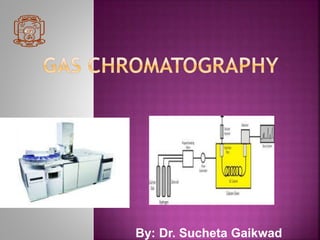
Gas chromatography sag2020
- 1. By: Dr. Sucheta Gaikwad
- 2. What is “chromatography” Principle of gas chromatography Theory of operation Components in technique Detectors Advantages Applications
- 3. 1903 - Mikhail Tswett separated plant pigments using paper chromatography liquid-solid chromatography 1930’s - Schuftan & Eucken use vapor as the mobile phase gas solid chromatography
- 4. The separation of mixtures into their constituents by preferential adsorption by a solid” “Chromatography is a physical method of separation in which the components to be separated are distributed between two phases, one of the phases constituting a Staionary phaseof large surface area, the other being a movingthat percolates through or along the stationary bed.”
- 5. It is basically a techq in which moving phase is gas where compound of vapourised sample are separated and fractionated as consequence of partition Between a mobile phase and stationary phase held in column sample Partition between phases Separated comp.
- 6. Gas Chromatography (Based on Stationary Phase) Gas liquid Chrmatography (GLC) Gas solid Chrmatography (GSC) Mobile Phase -Gas
- 7. Gas solid Chrmatography (GSC) Gas liquid Chrmatography (GlC) St.phase: Solid granular silica alumina or carbon Nonvolatile liduid on solid support (diatomaceous earth particles) Separation process: Adsorption Partition Applicable for Hydrocarbons Most of organic iorganic ,compd
- 10. Carrier gas (nitrogen or helium) Sample injection Long Column (30 m) Detector (flame ionization detector or FID) Hydrogen Air
- 11. Properties Inert Gas Available In Low Cost Response Towards Detector Helium (He), nitrogen (N2), hydrogen (H2), and argon (Ar). Helium and nitrogen - most commonly used Main disadvantage of hydrogen- explosion hazards *low density better---------- Separation Efficiency
- 12. Liquid or gas sample always injected by syringe through a silicone rubber diaphragm in the injection port.
- 13. Two types of column: Capillary column:Fabricated from capillary tubing,verythin,high efficiency with extremely small sample Packed column:Made up of stainless steel or cu tubing,folded coiled,stable at high temp Velocity of a compound through the column depends upon affinity for the stationary phase Area under curve is ______ of compound adsorbed to stationary phase Gas phase concentration Carrier gas mass
- 14. Particle size and surface area Rate of flow of carrier gas Type of stationary phase Column length Column diameter Column temperature Statinary phase: utilised should be thermally stable,chemically inert,low voltality and good solvent
- 15. Reuirements High sensitivity Stable Capable of operating at maximum suitable temperature Easy to operate An output signal is a linear function of the concentration of a sample
- 16. Thermal Conductivity Detector Flame Ionisation Detector Electron Capture Detector
- 17. •Working: Consist of Pt,Gold or Tungsten wire in whetstone bridge network •Detects based on difference in the thermal conductivity of carrier gas and separated sample from column stream •Thermal conductivity affects the resistance as a function of temperature
- 18. Advantage: Simple, inexpensive, accurate, non distructive of sample & Detects CO2 in flue gas Dis advantage: Less sensitive,Can be increased using He as a carrier gas
- 19. Hydrogen Air Capillary tube (column) Platinum jet Collector Sintered disk Teflon insulating ring Flame Gas outlet Coaxial cable to Analog to Digital converter Ions Why do we need hydrogen?
- 20. Working:Large number of organic compounds get pyrolysed when introduced in flame and produce ions. These ions are collected towards respective electrode. This changes potential difference between electrodes resulting current which is measured by amplifier i.e change in conductivity of flame when composition of gas mixture changed
- 21. Advanages: Responds to compounds that produce Ions when burned in an H2-air flame(all organic compounds) Highly sensitive, Linear response DisAdvantages: Complicated, expensive, distructiveof sample, functional groups like carbonyl ,halogen, amines not detected
- 22. Working principle: When gas eluted from column strikes at cathode a beam of free electrons produce by β emitter it collects at anode. This generates background signal to detect gas
- 23. Avdvantage: Highly sensitive selective towards analyte of electronegative functional groups such as halogens ,peroxides, nitro etc.Detection and determination of chlorinated insecticides,Dose not alter sample Disadvantage: Distructive,non linear response
- 24. W1/2 h
- 26. 1. Isobutane 2. n-Butane 3. Isopentane 4. n-Pentane 5. 2,3-Dimethylbutane 6. 2-Methylpentane 7. 3-Methylpentane 8. n-Hexane 9. 2,4-Dimethylpentane 10. Benzene 11. 2-Methylhexane 12. 3-Methylhexane 13. 2,2,4-Trimethylpentane 14. n-Heptane 15. 2,5-Dimethylhexane 16. 2,4-Dimethylhexane 17. 2,3,4-Trimethylpentane 18. Toluene 19. 2,3-Dimethylhexane 20. Ethylbenzene 21. m-Xylene 22. p-Xylene 23. o-Xylene
- 27. Column: Petrocol DH, 100m x 0.25mm ID, 0.5µm film Cat. No.: 24160-U Oven: 35°C (15 min) to 200°C at 2°C/min, hold 5 min Carrier: helium, 20cm/sec (set at 35°C) Det.: FID, 250°C Inj.: 0.1µL premium unleaded gasoline, split (100:1), 250°C Example Method
- 28. Problem: some components of a mixture may have very high velocities and others extremely low velocities. slow down fast components so they can be separated speed up slow components so analysis doesn’t take forever
- 29. Aromatics (benzene, toluene, ethyl benzene, xylene) Flavors and Fragrances Air pollutants Permanent gases (H2, N2, O2, Ar, CO2, CO, CH4) Hydrocarbons in petroleum industry Analysis of Alcohols in blood Pesticides, Herbicides, PCBs, and Dioxins Water analysis -dissolved gases Fatty acids in oils Separation of amino acids Determination of formaldehyde and phenols in resins *Compound must exist as a gas at a temperature that can be produced by the GC and withstood by the column (up to 450°C)
- 30. Both qualitative and quantitative analysis . Requires only very small samples with little preparation Good at separating complex mixtures into components Results are rapidly obtained (1 to 100 minutes) Very high precision Only instrument with the sensitivity to detect volatile organic mixtures of low concentrations Equipment is not very complex (sophisticated oven) Method applicable to about 60% of organic compounds Separation of isomers possible
- 31. Thank you !!!